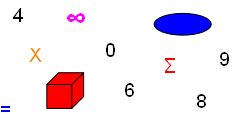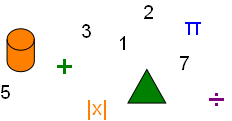



The Inverse of a Matrix


A square matrix that has an inverse is invertible (non-singular). Not every square matrix has an inverse.
Non-square matrices do not have an inverse and are singular. To show this we examine two matrices; A and B. If A is of order m×n and B is of order n×m where m ≠ n, the products of AB and BA cannot be equal, and by matrix multiplication definition AB and BA cannot be multiplied.
The inverse of a square matrix is easiest to understand if we begin with the equation ax = b where a ≠ 0. To solve this equation for x we multiply both sides of the equation by a−1:
ax = b
a−1 ax = a−1 b
x = a−1 b
a−1 is the multiplicative inverse of a because a−1 a = 1. This is similar to the definition of the multiplicative inverse of a matrix:
If we let A be an n×n matrix and let In be the n×n identity matrix then,
AA−1 = In = A−1 A
This identifies A−1 as the multiplicative inverse of A, the A inverse.
How to Find the Inverse of a Square Matrix using a System of Linear Equations:
By applying matrix multiplication to a square matrix of which we want to find the inverse and using the matrix equation AX = I to solve for X, when operations have been completed the square matrix X is the inverse matrix A−1, X = A−1, and we will have solved AA−1 = In. We show how to find the inverse of a 2×2 matrix; however this scheme applies to any square matrix:
Matrix A
2×2 | C1 | C2 |
R1: | 1 | 4 |
R2: | −1 | −3 |
Matrix X
2×2 | C1 | C2 |
R1: | X11 | X12 |
R2: | X21 | X22 |
Identity Matrix
2×2 | C1 | C2 |
R1: | 1 | 0 |
R2: | 0 | 1 |
Matrix A×X
=
Identity Matrix
1X11 + 4X21 1X12 + 4X22
−1X11 − 3X21 −1X12 − 3X22
1 | 0 |
0 | 1 |
Next, equate corresponding entries to obtain two systems of linear equations…
Linear Equations System 1
X11 + 4X21 = 1
−X11 − 3X21 = 0
Linear Equations System 2
X12 + 4X22 = 0
−X12 − 3X22 = 1
From the first system we determine that X11 = −3 and X21 = 1.
From the second system we determine −X12 = −4 and X22 = 1.
We now write the inverse of A as:
Matrix X (A-1)
2×2 | C1 | C2 |
R1: | −3 | −4 |
R2: | 1 | 1 |
It is recommended that you also understand the Gauss-Jordan Elimination method, especially if you are working with 3×3 matrices or larger. By solving both systems of linear equations simultaneously it is more efficient than solving for the inverse of a matrix.
Using the Matrix Formula to Find the Inverse:
The matrix formula works for 2×2 matrices. The following shows how the formula works.
Matrix A
a | b |
c | d |
If matrix A is invertible then ad − bc ≠ 0. Should ad − bc ≠ 0 the inverse of matrix A is given by:
A−1 = 1 / (ad − bc) × A
The denominator ad − bc is the determinant of the 2×2 matrix.
Matrix A
3 | −1 |
−2 | 2 |
ad − bc = (3)(2) − (−2)(−1) = 4
And A−1 = 1 / (ad − bc) × A = ¼ A
The inverse is a scalar multiplication of ¼ by the array elements of matrix A.
Copyright © DigitMath.com
All Rights Reserved.